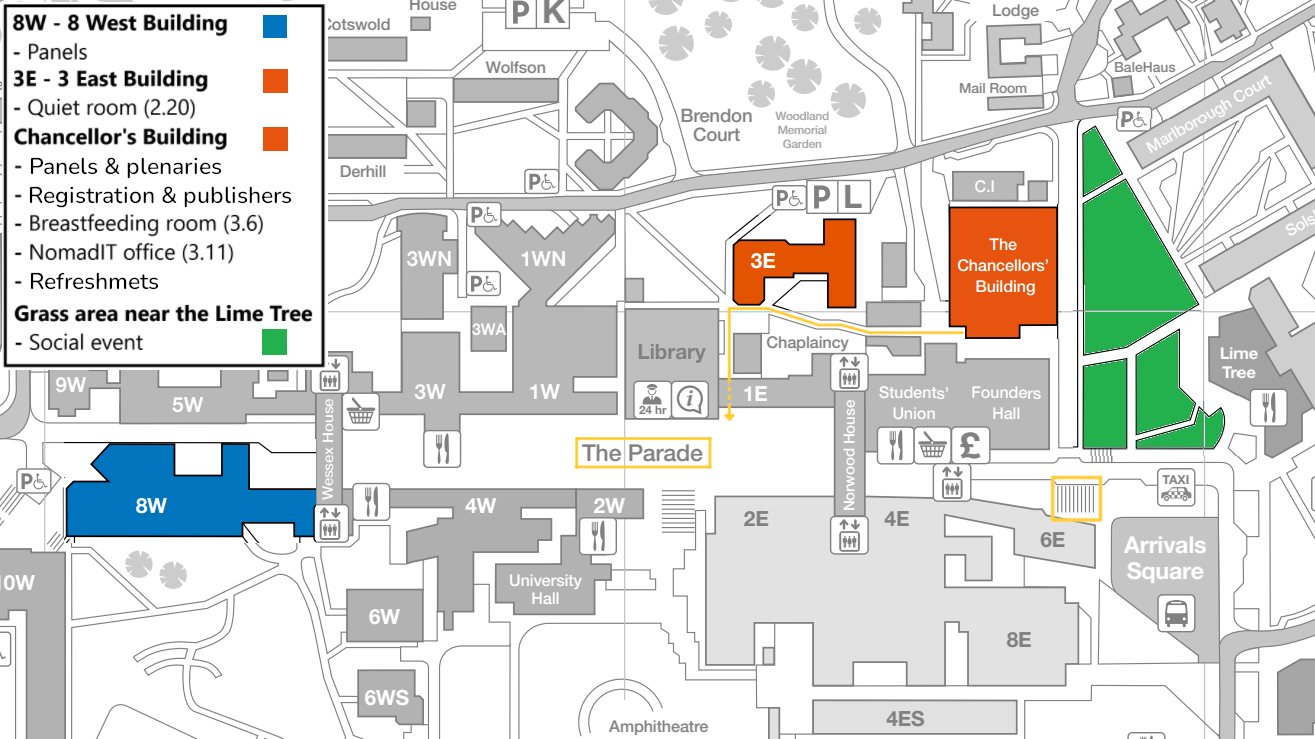Our Aims and Objectives
We are the UK association for all those who research, study and teach global development issues
Find Out MoreThe conference will take place at University of Bath, Claverton Down, Bath BA2 7AY. The coordinates are 51.378356676263444, -2.326345048418092.
Travelling by bus to the Claverton Down Campus from the Bath Spa City Centre
Bus services you can take you to and from the University’s Claverton Down campus where the DSA2025 conference is taking place.
For bus schedules, stops and updated, please the University of Bath (Bath Unibus) page. Please note that the conference is taking place during the Holiday season on the bus schedule. You can download the bus timetable in PDF format here.
Taxis can be found outside Bath Spa train station for approximately £10 – you can also use the Uber app which is slightly cheaper.
Visas and ETA
For all visa information, including the new Electronic Travel Authorisation, see our dedicated visa page.
Campus accommodation
Our main reception is in the East Accommodation Centre located opposite the entrance to the East Car Park. You can check into your room from 3pm.

London Airports
There are regular connections by rail and coach from London Heathrow and London Gatwick.
Our nearest airport is Bristol International Airport.
The A4 Air Decker bus service will take you directly from the airport to Bath.
You can also catch the Bristol Flyer Airport Express from the airport to Bristol Temple Meads rail station to travel to Bath by train.
Travelling from London to Bath by train couldn’t be easier. Take the train from London Paddington Station, where you can catch a direct train with Great Western Railway towards Bath Spa. The train travel from London to Bath can take as little as 1 hour and 20 minutes. You may need to change at Westbury or Swindon and depending on which route you choose, the journey can take up to 2 hours.
There are various trains departing from London:
Even though taking the train may be the quickest route, it can also be the most expensive. A super off-peak return train ticket costs £63 and off-peak returns cost £86.80, but these tickets are valid during restricted time periods. If you book early, you can buy cheap train tickets. Advance single tickets are one-way tickets and numbers are limited, so you’ll need to be quick.
Travelling from London to Bath by bus is the cheapest option, but it can take the most time. To travel by bus from London to Bath, take the National Express from Victoria Coach Station in central London. You will arrive at Bath Bus Station, which is centrally located, and the bus also stops at Heathrow Airport.
The first bus to Bath from London Victoria Coach Station leaves at 07:00 and the last bus leaves at 23:00. There is usually a bus service leaving London up to 9 times a day so you can choose when you want to depart. For return journeys, travelling from Bath to London by bus, the first National Express coach departs at 03:30 and the last bus leaves Bath at 20:15.
If there are a few people in your group and you want more flexibility as to when you travel from London to Bath, going by car might be the best option. However, it is worth remembering that you may need to pay a daily congestion charge of £11.50 for driving in the center of London, an emissions charge and toll fees depending on which route you take.
VIA WINDSOR
If you want to stop at Windsor on your way to or from Bath, take the A4 then the M4 towards South Gloucestershire and exit at junction 8. From there, continue on the A46 to Cheap Street in Bath city centre. This journey is 115 miles long and takes roughly 2 hours and 20 minutes, depending on traffic. You will drive through the North Wessex Downs and pass Windsor, Reading and Swindon. If you want to discover Windsor and Bath, this is the best route to take.
VIA STONEHENGE
Make it a historical road trip of some of Britain’s finest heritage and stop at Stonehenge on your way to Bath from London. You will need to travel on the A4, M4, M25, A303 and A36, which involves some toll roads. The 122-mile journey takes around 2 hours and 30 minutes, depending on traffic. This route will take you past Stonehenge in Amesbury on the A303. You can park at Stonehenge Visitors Centre and allow around 2 hours to explore the World Heritage Site. If you want to visit Stonehenge and Bath, this is the best route to take.
Whenever you drive in or around London, you should always be prepared for lots of traffic, especially during rush hour. Make sure you allow for additional time in case you get caught in traffic both in London and when you get to Bath. If you choose to drive past Stonehenge, you should also be aware that the A303 is notorious for heavy congestion.
If you need long stay parking in Bath, try the Charlotte Street, Manvers Street or Avon Street car parks where you will pay up to £15 for 12 hours. You can also stay for multiple days at all of these car parks at a cost of £15 per day. Charlotte Street is near The Crescent and The Circus, Avon Street is near the Thermae Bath Spa and Roman Baths, and Manvers Street is closer to Bath Abbey.
You can travel around Bath easily by walking, cycling or taking public transport or a city bus tour. Our open top bus tour takes you around all of the best sights in Bath and you can get on and off the bus as much as you want to and explore the city.
Getting to University of Bath, Claverton Down Campus
The main campus is located in Claverton Down, on the east side of Bath.
use ‘Norwood Avenue, Bath’, not ‘Quarry Road’, to get to the main entrance of the campus and visitor car parks if you are using a satnav.
BATH CLEAN AIR ZONE
If your vehicle does not meet emissions standards, you might need to pay to drive in a clean air zone.
If you are driving and need a parking spot at the university, please email the conference administrators for a pass.
Bath, located in Somerset, England, is a city rich in history and architectural beauty. It’s best known for its Roman-built baths, which were constructed around natural hot springs and remain one of the city’s most popular attractions. Bath’s charm is further enhanced by its stunning Georgian architecture, particularly the elegant Royal Crescent and The Circus, all built from the signature honey-coloured Bath stone.
The city is also home to Bath Abbey, a striking example of Gothic design, and the Jane Austen Centre, which celebrates the life and work of the famous author who once lived there. As a designated UNESCO World Heritage Site, Bath offers a unique blend of ancient history and refined elegance. Beyond its historical sites, the city boasts a vibrant cultural scene, including the Theatre Royal, a variety of restaurants, boutique shops, and the modern Thermae Bath Spa, where visitors can soak in warm mineral-rich waters just as the Romans did.
To find out more about Bath as a Heritage centre, visit this website.
BathChanging lives through art: Immerse yourself into arts and displays at the Museum. To book your tickets, visit their website.
Escape and connect to the seasons at our estate on the Bath skyline. Home to American stories, decorative arts, folk art and textiles, special exhibitions, acres of wildlife-friendly gardens and exciting events. Feel alive with nature and art, and relax at the American Garden Deli with its scenic valley terrace. To see what’s on, visit their website.
Childcare.co.uk is a useful website that connects parents with local childcare providers and sitters, you’ll need to create an account and provide some information, and we’d recommend organising this early, but could be very helpful.
Childcare in the UK is unfortunately expensive, the range will be between £40 and £80 per day, with the closer creches to the venue being more expensive due to the central location; nannies seem to cost on average £15 per hour.
The currency in the UK is GBP and Euros are rarely accepted anywhere. Since the pandemic, it is very rare that any service would ask for cash only; card and contactless, google pay, apple pay etc. are usable everywhere from market stalls, to buses, to tube stations. You may need coins to pay for public toilets however, which are not free in the centre or at the stations.
It is worth noting that Bath is one of the most expensive cities in the UK, by quite a margin, so it is advisable to come prepared and book things like accommodation well in advance to the conference.
Remember to pack adaptors, you will need a British three-prong adapter (if you have US/European three-prong bear in mind it is a different shape) if you have devices that use other plugs. British sockets also have a switch on them, make sure you switch it on to allow electricity flow and switch it off again before you unplug your device.
